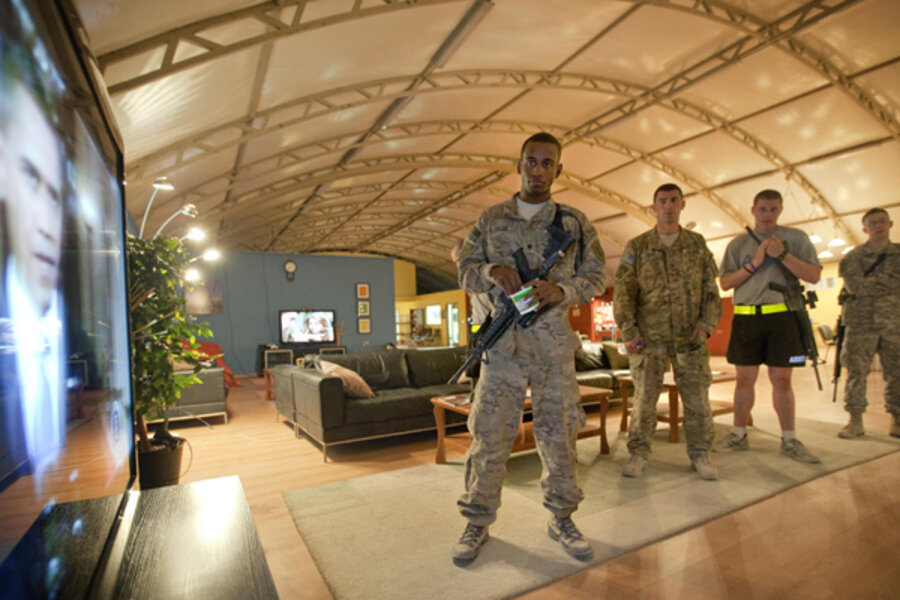Troop exit plan means hard choices for US commanders in Afghanistan
Loading...
| Washington
President Obama's decision that all 30,000 "surge" forces must be out of Afghanistan by the end of next summer is not what US military leaders were hoping to hear Wednesday night – and it portends some difficult choices ahead for on-the-ground commanders.
Those will fall mainly to incoming US commander in Afghanistan, Marine Lt. Gen. John Allen, who is slated to replace Gen. David Petraeus in September. Moreover, by the end of 2014, the US mission in Afghanistan will have transitioned from a combat role to a support role, Mr. Obama told the nation in his speech, which marked a pivot point in the 10-year US campaign in Afghanistan. He did not, however, specify how many US forces would remain in Afghanistan by then.
Obama “is betting that a smaller American force, combined with our NATO and Afghan allies, will be able to continue the counterinsurgency campaign until, by the end of 2014, only a residual presence of American advisers and special forces are required to secure American interests in the region,” says John Nagl, president of the Center for a New American Security, a think tank. “He is probably right, but John Allen will have some difficult choices to make about battlefield geometry,” military parlance for how and where he arrays his remaining forces.
Pentagon officials have warned that drawing down US troops before Afghan forces are ready to take over the fight against radical Islamist insurgents could threaten the “fragile and reversible gains” that the US military says it has made against the Taliban, particularly in southern Afghanistan.
But the president's timetable offers some flexibility for US commanders. Defense Secretary Robert Gates, who had lobbied for a more modest drawdown of 3,000 to 5,000 troops by year’s end, made that point in a statement supporting Obama’s plan.
“Over the past 18 months our troops have made tremendous progress degrading the capability of the Taliban while enhancing the Afghan security forces. It is critical that we continue to aggressively prosecute that strategy,” he said. “I support the President’s decision because it provides our commanders with enough resources, time and, perhaps most importantly, flexibility to bring the surge to a successful conclusion.”
Pentagon officials were relieved, for example, that Obama did not specify that the 10,000 US troops who must exit Afghanistan by year’s end have to be combat troops. Last week, 27 senators (25 Democrats and two Republicans) signed an open letter to Obama demanding a significant troop withdrawal and specifying that exiting troops should not be limited to support troops – such as base engineers and logisticians – but include combat troops.
The majority of surge forces are in southern Afghanistan – restive Helmand Province and the Taliban heartland of Kandahar. The US surge forces, combined with other NATO and Afghan troops, have given commanders an impressive ratio of one security force for every five to ten “military age males” in the general population, according to a US official, who asked not to be named because he was not authorized to speak about US military operations. “With those kinds of ratios, anything’s possible,” he adds.
Whether those gains will hold when US troops begin to depart – in other words, whether troops' ‘fragile and reversible gains’ are sustainable – will be the true test of US military success in the region, officials say.
“You take a brigade [approximately 5,000 US troops] out of the south, and you risk the reversion of that territory as a sanctuary for insurgents,” says Richard Fontaine, a former foreign policy adviser to Sen. John McCain (R) of Arizona, the Senate Armed Services Committee’s top Republican, and a senior fellow at the Center for a New American Security.
Eastern Afghanistan, where surge forces are fewer, must also be a concern for General Allen. There, US troops face the Haqqani network, which many US military commanders consider to be more deadly than the Taliban – and with closer ties to Al Qaeda.
The Haqqani network also has the benefit of sanctuaries in the North Waziristan region of Pakistan. “Our efforts must also address terrorist safe havens in Pakistan,” Obama acknowledged Wednesday night.
“The military has fought very, very hard to make progress in the south and the east of Afghanistan,” says Mr. Fontaine. “But with less troops, you have less ground you can cover, less places you can go, less people to fight,” he adds. “You’re going to have to do some of these same tasks with less people.”
For his part, Obama acknowledged Wednesday that there is more work to be done. “This is the beginning, but not the end,” he said, “of our effort to wind down this war.”





